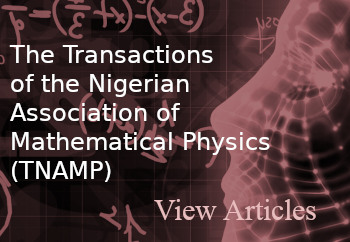ANALYSIS OF ATMOSPHERIC STABILITY AND CONVECTIVE ACTIVITIES FOR RADIO APPLICATIONS OVER SELECTED LOCATIONS IN NIGERIA
DOI:
https://doi.org/10.60787/jnamp-v67i1-349Keywords:
Stability Indices, Troposphere, Thermodynamic Processes, Convective Activity, Atmospheric IndicesAbstract
This study investigates the thermodynamic structure of the convective atmosphere during the rainy period of March to October, and the dry period of November to February, in the southwestern part of Nigeria. Eight (8) years of re-analysis data, spanning January 2011 to December 2018 across five stations in southwestern Nigeria were employed for the study. The stability indices employed for the analysis include Humidity Index (HI), K-index (KI), Boyden-index (BI) and the Total-totals index (TT). Frequency of occurrence, spatial distribution, monthly variation and time series analyses of the indices established the predominance of thunderstorm activities at the locations during the rainy months of March to October. This underscores the high suitability of the stability indices for predicting atmospheric convective activities in these locations. The results play important role in providing relevant data for radio link designers, meteorologists, and aerospace practitioners, for effective planning and design of atmospheric operational activities.
Downloads
References
Ogunjo, S. T., Adedayo, K. D., Ashidi, A. G., & Oloniyo, M. I. (2013). Investigating wind-solar hybrid power potential over Akure, southwestern Nigeria. J Niger Assoc Math Phys, 23, 511-516.
Ashidi, A. G., Ojo, J. S., Adediji, A. T., & Ajewole, M. O. (2017). Characterization of Ku-band amplitude scintillation on earth-space path over Akure, SW Nigeria. In Proceeding of XXXII general assembly and scientific symposium, URSI.
Ashidi, A. G., Dada, J. B., & Lawal, Y. B. (2020). Spectral analysis of Ku-Band scintillation dataset for satellite communication in a tropical location. In 2020 International Conference in Mathematics, Computer Engineering and Computer Science (ICMCECS) (pp. 1-5). IEEE.
Kayode, A., Ayodeji, A., Samuel, O., & Moses, A. (2019). Variation of surface refractivity with soil permittivity and leaf wetness in a tropical location. Int J Wireless Microwave Tech, 9(4), 26-38.
De Vries, A. J. (2020). A global climatological perspective on the importance of Rossby wave breaking and intense moisture transport for extreme precipitation events. Weather and Climate Dynamics Discussions, 2020, 1-56.
Matthew, O. J., Abiye, O. E., & Ayoola, M. A. (2021). Assessment of static stability indices and related thermodynamic parameters for predictions of atmospheric convective potential and precipitation over Nigeria. Meteorology and Atmospheric Physics, 133, 675-691.
Temme, M. M., Gluchshenko, O., Nöhren, L., Kleinert, M., Ohneiser, O., Muth, K., ... & Biondi, R. (2023). Innovative Integration of Severe Weather Forecasts into an Extended Arrival Manager. Aerospace, 10(3), 210.
Kauristie, K., Andries, J., Beck, P., Berdermann, J., Berghmans, D., Cesaroni, C., ... & Österberg, K. (2021). Space weather services for civil aviation—Challenges and solutions. Remote Sensing, 13(18), 3685.
Falodun, S. E., Ojo, J. S., & Kareem, A. I. (2021). The Study of Atmospheric Stability Using Radio Refractivity Profiles Over a Tropical Climate in Nigeria. MAPAN, 36(4), 751-762.
Li, X., Zhang, Q., Fan, J., & Zhang, F. (2021). Notable contributions of aerosols to the predictability of hail precipitation. Geophysical Research Letters, 48(11), e2020GL091712.
Nasrazadani, H., Sedighi, A., & Seifi, H. (2023). Enhancing static voltage stability of a power system in the presence of large-scale PV plants using a battery energy storage control scheme by the probabilistic technique. International Journal of Electrical Power & Energy Systems, 144, 108517.
Reuter, G. W., N. Aktary, 1993: A slantwise Showalter index based on moist symmetric instability: Results for Central Alberta, Atmosphere – Ocean, 31, 379-394.
Seto, T. H., Yamamoto, M. K., Hashiguchi, H. and Fukao, S. (2004). Convective activities associated with intra-seasonal variation over Sumatera, Indonesia, observed with the equatorial atmosphere radar. Annales Geophysicae (2004) 22: 3899–3916
Samanta, S., Tyagi, B., Vissa, N. K., & Sahu, R. K. (2020). A new thermodynamic index for thunderstorm detection based on cloud base height and equivalent potential temperature. Journal of Atmospheric and Solar-Terrestrial Physics, 207, 105367.
Moustakis, Y., Onof, C. J., & Paschalis, A. (2020). Atmospheric convection, dynamics and topography shape the scaling pattern of hourly rainfall extremes with temperature globally. Communications Earth & Environment, 1(1), 1-9.
Lenderink, G., Barbero, R., Loriaux, J. M., & Fowler, H. J. (2017). Super-Clausius–Clapeyron scaling of extreme hourly convective precipitation and its relation to large-scale atmospheric conditions. Journal of Climate, 30(15), 6037-6052.
Ali, H., Fowler, H. J., & Mishra, V. (2018). Global observational evidence of strong linkage between dew point temperature and precipitation extremes. Geophysical Research Letters, 45(22), 12-320.
Schroeer, K., & Kirchengast, G. (2018). Sensitivity of extreme precipitation to temperature: the variability of scaling factors from a regional to local perspective. Climate Dynamics, 50(11), 3981-3994.
Zhang, W., Villarini, G., & Wehner, M. (2019). Contrasting the responses of extreme precipitation to changes in surface air and dew point temperatures. Climatic change, 154(1), 257-271.
Roderick, T. P., Wasko, C., & Sharma, A. (2019). Atmospheric moisture measurements explain increases in tropical rainfall extremes. Geophysical Research Letters, 46(3), 1375-1382.
Mattingly, K. S., & Mote, T. L. (2017). Variability in warm-season atmospheric circulation and precipitation patterns over subtropical South America: relationships between the South Atlantic convergence zone and large-scale organized convection over the La Plata basin. Climate Dynamics, 48(1-2), 241-263.
Prein, A. F., Liu, C., Ikeda, K., Bullock, R., Rasmussen, R. M., Holland, G. J., & Clark, M. (2020). Simulating North American mesoscale convective systems with a convection-permitting climate model. Climate Dynamics, 55(1), 95-110.
Liu, C., Ikeda, K., Rasmussen, R., Barlage, M., Newman, A.J., Prein, A.F., Chen, F., Chen, L., Clark, M., Dai, A. and Dudhia, J. (2017). Continental-scale convection-permitting modeling of the current and future climate of North America. Climate Dynamics, 49(1), 71-95.
Elliot, W. P., D. J. Gaffen, 1991: On the quality of radiosonde humidity archives for climate studies, Bulletin of the American Meteorological Society, 72, 1507-1520.
MacGorman, D.R., and W.D. Rust, 1998: The Electrical Nature of Storms. New York: Oxford University Press.
Williams, E. R., 1995: Meteorological aspects of thunderstorms, in CRC Handbook on Atmospheric Electrodynamics, edited by H. Volland, pp. 27-60, CRC Press, London,UK.
Emmanuel, K.A., 1994: Atmospheric Convection. Oxford University Press
Rackliff, P. G., 1962: Application of an instability index to regional forecasting, Meteor. Magazine, 91,113-120.
Downloads
Published
Issue
Section
License
Copyright (c) 2024 The Journals of the Nigerian Association of Mathematical Physics

This work is licensed under a Creative Commons Attribution-NonCommercial-ShareAlike 4.0 International License.




